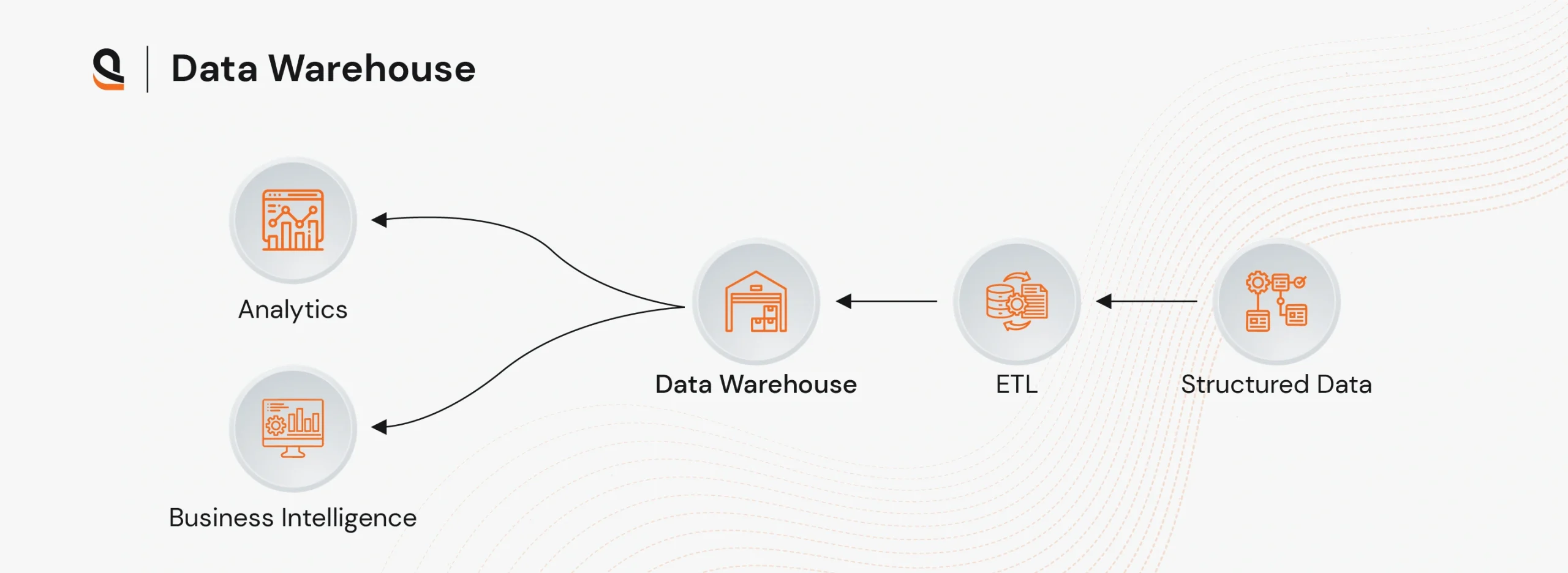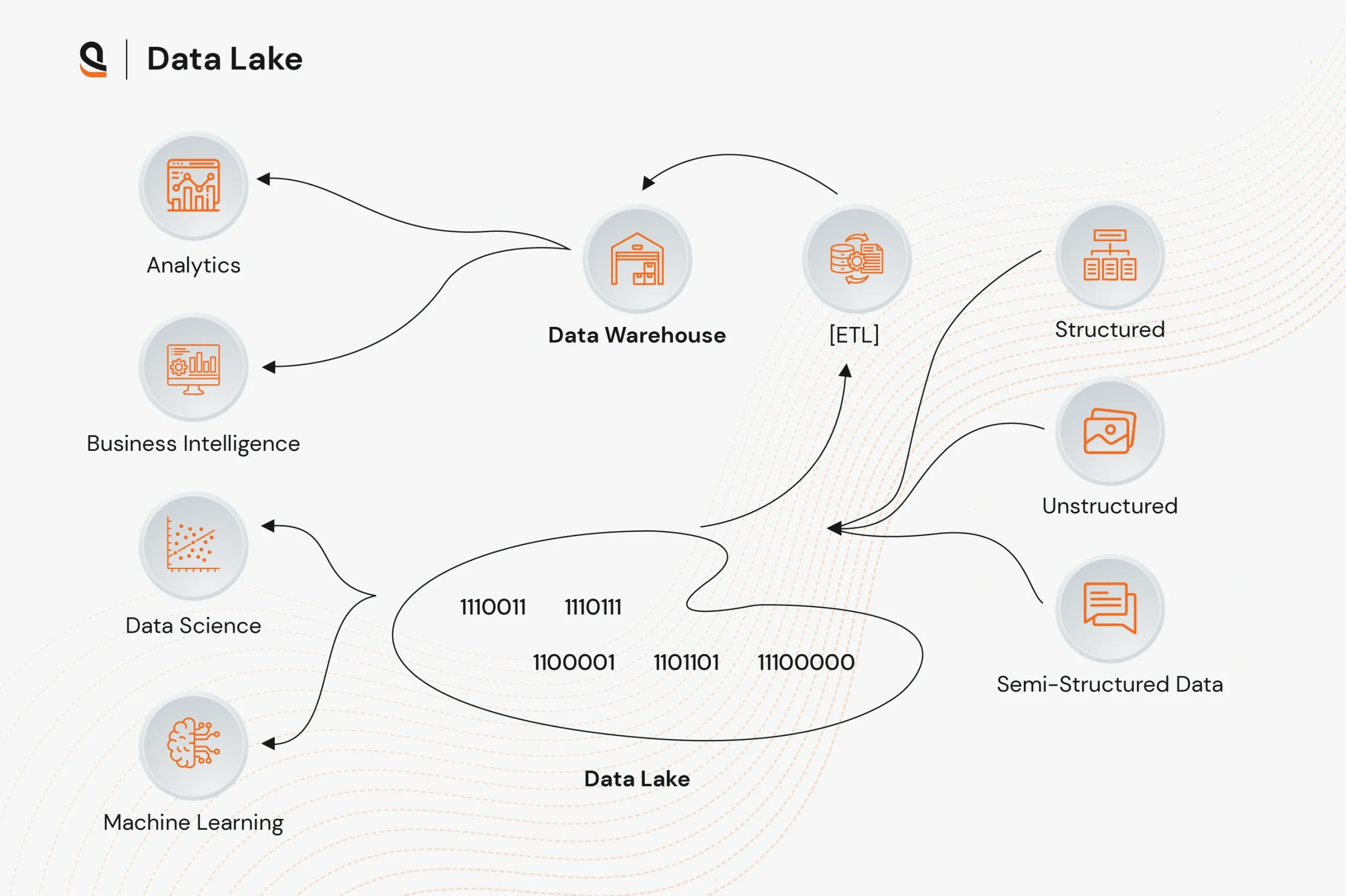As more industries and businesses rely on technologies for their operations, the amount of data consumed and produced worldwide is increasing daily. According to a report by Statista, the volume of data created, captured, copied, and consumed around the globe was 149 zettabytes in 2024 and is expected to grow to more than 394 zettabytes by 2028.
Data has become a company’s most important asset, so has its storage, management, analysis, and security. Data accessibility is another important aspect to consider when making the most of the available data. Data Lakehouse vs. Data Warehouse vs. Data Lakehouse has been a hot topic among data experts as they try to decide which is the best data storage approach for data analytics.
Data warehouses and data lakes have long been widely used data storage architectures; however, data lakehouses are also becoming a preferred architecture. They are a new data storage architecture that exhibits the flexibility of data lakes and the data management capabilities of enterprise data warehouses.
Understanding the multiple big-data storage techniques is instrumental in developing a robust data storage ecosystem for business intelligence (BI), data analytics, machine learning (ML), and other operations. As an enterprise data management and analytics service provider, we help enterprises select the most suitable data storage techniques for their business needs.
What is a Data Warehouse?
A data warehouse architecture is a centralized data storage approach that aggregates and stores structured data (sometimes semi-structured) collected from multiple sources within an organization. It collects data from databases, cloud applications, and external data feeds. An enterprise data warehouse helps organizations with business intelligence, data mining, and data management activities such as performance reporting, trend analysis, and compliance reporting.
Due to their highly structured nature, enterprise data warehouses standardize and consolidate data from multiple sources. They help businesses perform complex queries and analyze data to support data-driven decision-making.
Why Use a Data Warehouse
Data warehouse architecture is preferable when organizations have vast amounts of data history to store and want to perform in-depth analysis of data to extract business intelligence. The data warehouse is extensively structured, making it easy to perform accurate data analytics.
Data Warehouse Tools:
- Amazon Redshift
- Google BigQuery
- IBM Db2 Warehouse
- Microsoft Azure Synapse
- Oracle Autonomous Data Warehouse
- Snowflake
- Teradata Vantage
Use Cases:
Enhanced Business Intelligence
Collect and store data from different sources using data warehouse architecture, enabling comprehensive business intelligence (BI) and other reports. Make data-driven decisions and perform accurate data analytics by implementing this approach.
Historical Data Analysis
Store and analyze the data to perform different analyses and predictions, and identify hidden patterns from the available historical data. Businesses can leverage data warehouse architecture to make data-driven decisions and strategize business plans.
Regulatory Compliance Reporting
Streamline the process of generating reports required to adhere to regulatory compliance by leveraging the centralized repository of structured data.
What is a Data Lake?
A data lake is a centralized repository that gathers data from diverse sources and retains it in its raw, unprocessed form. It stores massive volumes of both real-time and historical data in various formats such as JSON, BSON, CSV, TSV, Avro, ORC, and Parquet. Data professionals leverage data lakes to perform advanced analytics and uncover actionable insights, empowering businesses to make informed, data-driven decisions.
Why Use a Data Lake?
Data lakes are used to store massive datasets cost-effectively. Businesses use them to extract actionable insights from current and historical data jointly in their raw form without transforming. Data lakes are widely used in machine learning and predictive analytics as they provide storage and compute capabilities, independently or together.
Note that, like data warehouse architecture, data lakes are not preferable for an application’s transaction and concurrency needs.
Data Lake Tools
- AWS S3
- Azure Data Lake Storage
- Databricks Delta Lake
Use Cases:
Storage of Diverse Data Types
A data lake can store a large volume of data of every type- structured, semi-structured, and unstructured data in its original, raw form. This flexibility supports various data analytics and processing needs without the constraints of predefined schemas.
Big Data Processing
A data lake can be implemented to process huge data, perform advanced data analytics services, and enable machine learning (ML) applications. The scalable nature of data lakes allows for efficient handling of big data workloads.
Internet of Things (IoT) Data Management
Choose a data lake to manage and analyze data generated from IoT devices. The ability to ingest and store real-time streaming data makes data lakes suitable for deriving insights from sensor data and other IoT sources.
What Is a Data Lakehouse?
Data Lakehouse is a hybrid approach that offers the flexibility and scalability of a data lake with structured data management. It enables ACID transactional support and the high-performance querying capabilities of an enterprise data warehouse, making it an ideal choice for data-driven organizations. It provides a unified repository to store unstructured and structured data together. It empowers organizations with a single platform to store, manage, and analyze all data types.
Data lakehouses are considered best for organizations handling large data volumes of multiple formats. The architecture of Data Lakehouse supports an array of workloads such as machine learning (ML), real-time data streaming, and business intelligence (BI), getting reported from a single platform.
Why Use a Data Lakehouse?
Data Lakehouse enables seamless storage, management, and analysis of structured and unstructured data by merging data lakes’ scalability with data warehouses’ reliability. Data Lakehouse can support ACID transactions, real-time analytics, and AI/ML workloads that help eliminate silos and control costs. It ensures high-quality data with schema enforcement and governance, allowing well-informed decision-making.
The unified approach of Data Lakehouse helps organizations enhance performance, flexibility, and accessibility, making it the best option for data-driven enterprises.
Datalake House Tool:
- Starburst Data Lakehouse
Use Cases:
Augment Data Lake’s Capabilities
When you already utilize a data lake but want to add SQL performance capabilities to it while saving on the cost of creating and maintaining a separate enterprise data warehouse, consider adopting a data lakehouse. This approach enhances query performance without the complexity of a two-tier architecture.
Improve Data Compliance with Low-Cost Storage
Choose a data lakehouse to enhance data security, reliability, and compliance while maintaining large amounts of data in cost-effective lake storage. The unified architecture ensures robust governance without incurring high storage expenses.
Hybrid Data Analytics
Opt for a data lakehouse to process both structured and unstructured data seamlessly. This capability makes it an excellent choice for hybrid data analytics, supporting diverse workloads and analytical approaches within a single platform.
Data Warehouse vs. Data Lake vs. Datalakehouse: Which Approach Is Best?
Data Storage Solutions Comparison
| Feature | Data Warehouse | Data Lake | Data Lakehouse |
| Purpose | Structured analytics & reporting | Store raw data for various use cases | Combines analytics + raw storage |
| Data Types | Structured (tables, schema-defined) | All types (structured, semi-structured, unstructured) | All types (like data lakes) |
| Data Processing | ETL (Extract → Transform → Load) | ELT (Load → Then transform as needed) | Flexible ETL or ELT |
| Speed & Performance | High performance for SQL queries | Slower for analytics | High performance + flexible queries |
| Use Cases | Business Intelligence, Dashboards | Data Science, AI/ML, Backup | Unified BI & AI/ML use cases |
| Tools/Tech Examples | Snowflake, BigQuery, Redshift | Hadoop, AWS S3, Azure Data Lake | Databricks, Snowflake (new), Dremio |
| Data Governance | Strong and mature | Less mature | Improving with modern solutions |
| Scalability | Moderately Scalable | Highly scalable | Highly scalable |
| Real-Time Capabilities | Limited | Better suited for real-time pipelines | Supports real-time + batch |
Building a data lakehouse from scratch is a complex process. And businesses prefer a platform that is built to support open data lakehouse architecture. So, businesses should research each platform’s different capabilities or consult data experts to guide them thoroughly.
Data warehouse architecture suits companies that need a strong, structured solution centered on business intelligence and data analytics to generate actionable insights. On the other hand, enterprises aiming for a flexible, cost-effective solution for handling big data should consider data lakes, which also support machine learning and data science workloads using unstructured data.
If your current data warehouse or data lake approach isn’t meeting your company’s data needs, or you’re exploring better implementation strategies, consider advanced analytics and machine learning workloads on your data. In that case, a data lakehouse is a reasonable choice.
A data lakehouse is an ideal choice for businesses looking for comprehensive solutions to implement both advanced analytics and machine learning workloads on data.
Conclusion
Selecting the right data storage and management approach is crucial in today’s digital landscape, as most businesses are data-driven in one way or another. Data management and storage must be scalable, flexible, accessible, and above all, secured. At AQe Digital, your reliable go-to digital transformation partner, our data experts assist you throughout your data solution journey, from scratch. As an enterprise data solution company and leading IT services provider, we offer comprehensive data solutions to help you make the most out of your data with our innovative approach driven by advanced technologies.




